When looking for a new snare drum or shell pack, the drum shell material and construction are often overlooked by beginner and even intermediate drummers. The colour and finish of the shell are great, but does it sound the way you want?
Here we will look over different drum shell types and discuss their sonic properties to find which shell is suitable for different drummers.
Wood drum shells
Wood is the most common material used for drum shells. These types of shells produce a wide variety of sounds, ranging from warmer tones to sensitive, articulate sounds.
There are infinite options of drum sounds when looking into wooden shells as there are so many different species of timber to choose from. When deciding which wood to go for, it’s important to consider the type of music you want to play.
If you’re after a more unique sound, less conventional wooden shells are a great place to start. Whilst maple and birch are used for genres like jazz and rock, the less commonly used ash or beech will provide a slightly different sound.
Maple
Maple is an all-purpose, versatile wood when used as a drum shell. It produces a nice, even amount of high and mid-level tones with a slightly warmer low-end. And it’s because of this balance between brightness and warmth that maple is great when used for jazz, rock, and pop.
Its powerful tone projects with clarity, cutting through to the forefront of the mix with a perfect blend of depth, sustain, and attack. Maple is also favoured by many studio engineers and recording artists as it’s incredibly easy to mic up and record. This makes maple drum shells the perfect choice for drummers heading out to the stage or studio.
Mahogany
Mahogany is a great choice for jazz drummers, offering warm, rich, and vibrant tones.
The highs can be somewhat muted, but there’s an incredibly smooth midrange and a rich, warm low tone. Mahogany is commonly used in jazz due to its vibrant and resonant sound and its ability to provide a clear snap tone when tuned high.
Additionally, mahogany shells are aesthetically astonishing, providing a vintage look with the natural wood grain on show.
Birch
Birch shells are incredibly versatile as they can be tuned to suit most drumming styles. Because of this, they’re extremely popular with beginner and intermediate drummers learning a range of drumming techniques and styles.
They’re also incredibly durable, making them an even stronger choice for hard-hitting beginners.
In terms of tone, they produce boosted high frequencies with a reduced midrange and a great punch in the low end. The enhanced bass frequencies help provide the aggressive tone that birch is renowned for whilst remaining incredibly well balanced.
Oak
Another all-purpose wood, oak offers exceptionally warm tonal qualities and a full-bodied presence when tuned high.
Although less common than other wood shells, oak wood is renowned for its soft highs, accurate mid-range, and warm low tones. It boasts an incredibly solid, durable grain that adds bags of presence to your performances. But thankfully it’s not all bark – there’s certainly plenty of bite. The complete sonic range makes it perfectly equipped for both the studio and stage.
Walnut
Walnut is often favoured by furniture makers for its beauty and durability, which is why they make for great drum shells.
They produce an equal amount of highs, mids, and lows to create a big, warm sound. Walnut also produces a naturally EQ’d tone that works perfectly for stage and studio drumming alike.
No matter what style you’re drumming in, walnut is a great choice for a well-balanced sound.
Beech
Beech is an ideal choice for drummers looking for a more unique tone. With pronounced highs and mids and a good low-end punch, beech wood offers a sensitive and focused sound. It works well in various drumming styles and is the perfect choice for both live and studio environments.
In addition to the tone, beech wood offers a great aesthetic due to the unique grain in the wood.
Cherry
Cherry wood projects an extremely warm tone and features boosted highs, a punchy midrange, and an average low-end. Its sound is incredibly bright and sensitive with a powerful, deep tone and great projection. This makes cherry wood shells ideal for any stage – and they can be used for a range of drumming styles.
Bubinga
If you’re a rock or metal drummer, this one’s for you.
Bubinga is extremely punchy and sensitive, with an even level of mid and high frequencies and a very rich low-end tone.
The dark tone of bubinga makes it ideal for complementing louder and heavier styles, such as rock and metal. These drum shells will punch through the mix with a warm and aggressive attack.
Poplar
Poplar offers soft highs and mids with a boosted low-end warmth. The sound is smooth and even, making it suitable for a range of styles.
Regardless of how hard you hit a poplar drum, the sound will be clear and controlled.
Poplar drum shells are also extremely versatile, offering a bright, piercing sound whilst remaining warm and open with a very well-balanced sustain. And not only are they suitable for a range of drumming styles, but they’re also ideal for studio recording and live performances alike.
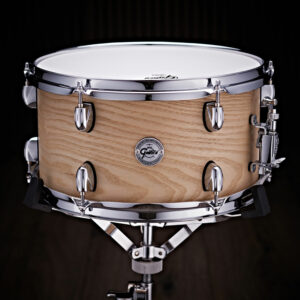 Ash
Ash
Ash is well-balanced in both resilience and hardness, making it a great choice for durable, light, and resonant drums.
These shells provide pronounced and cutting sounds, with warm highs and mids and average lows.
When tuned up, they provide a precise tone with rapid responses, while lower tuning results in a much fatter tone.
As well as the sound and durability, ash wood also provides a great advantage to the aesthetics of the drum.
Its natural woodgrain is extremely smooth and subtle – making natural and coloured drum shells look stunning.
Metal drum shells
Metal drum shells produce a very different sound to their wooden counterparts. They’re typically welded, cast, or handspun.
Like wood shells, there are a lot of different metal alloys to choose from. Again, it’s important to consider the style of drumming you’re interested in as this will have a great impact on which shell material is right for you.
 Steel
Steel
Steel is an all-purpose metal shell.
Commonly used on snare drums, it’s ideal for drummers looking for a powerful snare that’s capable of a variety of playing styles.
It offers clear highs and an average mid-range and low-end. Plus, it provides a clear sound across all tuning ranges.
Although they’re well-suited to heavier music due to their high-power sound, steel shells are also very popular for other styles. Reggae drummers, for example, often depend on steel snares for their bright, cutting sound qualities.
Steel shells stand out thanks to their incredibly bright tone, long sustain, and powerful rimshot sounds.
They’re also more responsive than most wood-shell snare drums, making them incredibly responsive to even the lightest of hits.
Aluminium
Aluminium drum shells have a sensitive and colourful sound quality. The midrange is open and warm with crisp highs and low-end definition. Aluminium is well-known in the drumming world for providing a powerful yet dry tone. This makes it the perfect choice for drummers who want a vintage-sounding drum. As well as the sound, aluminium shells provide an extremely vintage aesthetic, looking perfect on any stage.
Brass
Brass shells are vibrant and warm, with open highs, mids, and lows. They’ve been a favourite amongst drummers for many years due to their versatile sound, response, and aesthetics. Perfect for louder genres like rock and metal, brass is renowned for being quite loud. Having said this, you can use a brass snare in just about any style if you really want to cut through.
Copper
Copper snare drums are a rising feature in the drumming world. They can be described as a hybrid between wood and metal due to their deep low end and organic warmth and responses.
Although similar to a brass shell, copper provides less brightness and more warmth. Additionally, copper shells tend to have fewer overtones and make it easier to control any excess ringing and other unwanted sounds.
It’s powerful and loud when used as a drum shell – perfect for bigger stages and drumming styles that require an added punch. Expect muted highs, a low-end sound, and a distinctive midrange.
Titanium
Titanium’s sound is less metallic than other metal shells. It provides clear highs and mids, a boxy low end, and exceptional projection when hit hard, all whilst delivering a clear and focused tone. Titanium shells are often very sensitive, therefore responding beautifully to the dynamics of your playing.
From live performance work to studio recordings, these shells can be tuned down for a husky bark or tuned tight for a sound that can muscle through the thickest mix.
Bronze
Bronze shells are incredibly musical and are favoured by many well-known drummers such as Danny Carey and Dave Grohl.
These shells are also extremely loud, filling up the room with their huge sound – perfect for more aggressive styles such as rock and metal.
Plus, they can be great for ghost notes and light articulation. They’re renowned for their muted highs and powerful mid-range tones – providing warm characteristics with rapid responses.
Synthetic drum shells
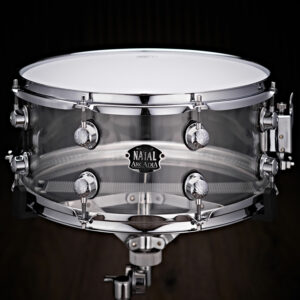 Drummers often overlook synthetic shells in favour of wood or metal shells. Their unique quality, however, shouldn’t be forgotten! Drums made from synthetic shells generally produce an extremely clean and focused sound – often more so than their wood or metal counterparts.
Drummers often overlook synthetic shells in favour of wood or metal shells. Their unique quality, however, shouldn’t be forgotten! Drums made from synthetic shells generally produce an extremely clean and focused sound – often more so than their wood or metal counterparts.
These shells are also surprisingly versatile and can be integrated into any drummer’s setup.
Carbon fibre
Carbon fibre is a great choice for drummers looking for a dry and controlled sound. It offers an even level of highs and mids, with added warmth in the low-end.
Perfectly suited to any stage or studio, carbon fibre shells catch the eyes and ears of the audience with their unique, versatile tone and stunning aesthetic.
Acrylic
Acrylic drum shells have a strong presence and powerful attack.
They’re warm across all frequency levels, including low, middle, and high.
Famously played by John Bonham and Ringo Starr in the ’70s, acrylic drums have long been a talking point in the drumming world.
They’re often unfairly associated with brash playing but, actually, acrylic shells are very diverse and suitable for a variety of musical styles and settings.
The acrylic construction produces a strong attack with clear, balanced sounds that are well suited to a range of genres.
They also offer a unique transparent aesthetic that looks great on any stage.
Fibreglass
Fibreglass drums are louder than most other shell materials and offer great consistency and versatility.
Similar to acrylic shells, they provide an extremely focused and controlled sound that is even across all ranges.
Hybrid shells
A hybrid shell is when two materials combine to make one. This could be two different kinds of wood or wood and metal, for example.
Each combination produces a unique and distinctive sound that can be perfect for a certain style of drumming. One great hybrid construction is when acrylic meets wood. These shells create some of the coolest tones with a stage-ready look. They look even better with the addition of LED lighting inside the shell, shining through the strip of acrylic.
The most common hybrid shells tend to be a common, softer wood such as maple with an inner ply of a hardwood, such as wenge. When placed in the middle of the shell, this hardwood offers a versatile, rich tone that sounds beautiful at all dynamics. The sandwiched construction also creates an enhanced low-end, adding great presence to your performance.
Another way of creating a hybrid shell is by introducing an inlay, made from a different material to the shell. By adding this to the outer ply, the shell gains added power and durability whilst offering a unique aesthetic – no two inlay shells are the same due to the natural grain of the wood.
Shell construction
Found the material for you? What about the construction? The way the shell is made is another major factor in its sound and durability.
Each construction type has its own unique benefits, so it’s a good idea to look over the options and decide which suits you best. In addition to the material and construction, the thickness of the shell has a great impact on the overall tone.
Some shells even have reinforcement hoops on the top and bottom of the interior. These add additional strength and stability to the wood, helping thinner shells produce a more rounded tone.
Wood construction
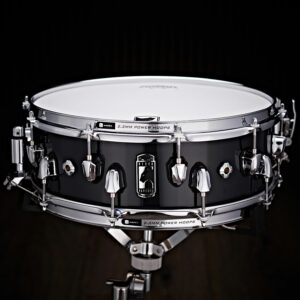 There are five different construction methods for wooden shells: plywood, stave, steam-bent, solid, and segment.
There are five different construction methods for wooden shells: plywood, stave, steam-bent, solid, and segment.
Plywood
Plywood shells are formed from thin layers of wood that have been laminated together.
The number of layers, or plies, plays a huge role in the final sound of the drum. For example, a 10-ply snare drum would be very powerful, delivering a deep tone that would perfectly suit metal and heavier styles. On the other hand, a 6-ply drum would be much more versatile.
Plywood construction is a popular method as it provides a long sustain with plenty of volume and a varying fundamental pitch.
Stave
A stave construction is similar to that of a barrel. Pieces of wood are laid vertically with the edges bevelled for a circular shape. This construction provides a higher fundamental pitch with a short sustain.
Steam-bent
As the name suggests, these shells are formed through steam technology. Steam-bent shells provide a vibrant sound with a true fundamental pitch and a long sustain.
Solid
Solid shells tend to be the most expensive. This is because of the careful, detailed craftsmanship and time required to make them. Solid shells offer an outstanding tuning range with superior projection and sensitivity. They also offer a long sustain with a higher fundamental pitch.
Segment
Segment shells are made from horizontal cuts of wood stuck together. This construction provides a unique aesthetic due to the horizontal grain. It also uses less glue than ply shells.
These shells aren’t stressed into shape, meaning they hold their form very well. Due to the individual pieces, it’s very easy to make mixed wood shells and, therefore, a customised drum sound.
Segment shells tend to offer a higher and more focused fundamental pitch with a short sustain.
Metal construction
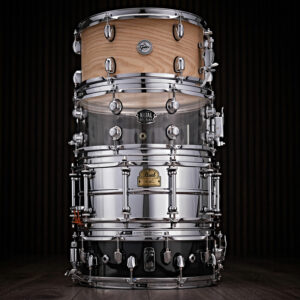 There are three common construction methods for metal shells: cast, spun, and welded.
There are three common construction methods for metal shells: cast, spun, and welded.
Cast
Cast drum shells are made from pouring liquid metal into a drum shell cast. This is then shaved away until the intended shape and thickness are achieved. The cast shell design provides a high fundamental pitch with a long sustain.
Spun
Spun construction is similar to cast, but it involves drilling the shell to the preferred shape and size. Spun shells typically produce a vibrant, true fundamental pitch with a long sustain.
Welded
Welded shells fuse metal together to create the desired shape and thickness. This is a low-intensity process, allowing the shells to be mass produced at a low-cost.
However, this construction disrupts some of the airflow and shell vibration inside the drum. The result is a tone that isn’t quite as full-bodied and rich as you would find in a seamless shell.
Find out more
Now that you have a better idea of what different shell materials can offer, why don’t you check them out for yourself?

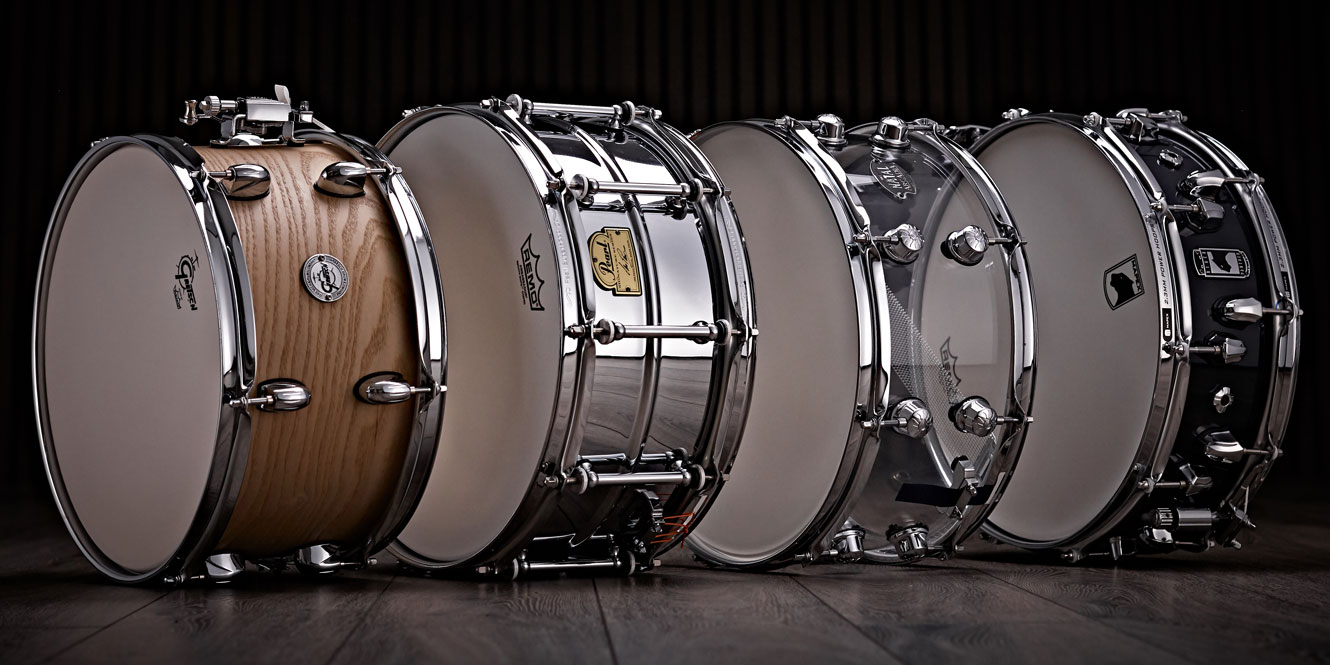











0 Comments